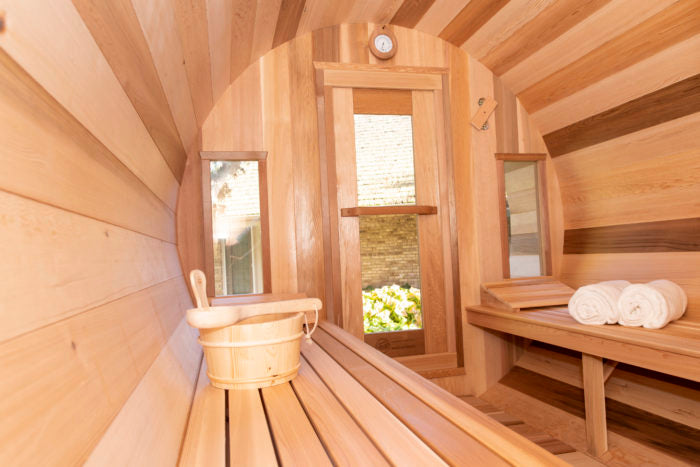Our Traditional Sauna Ideas
Our Traditional Sauna Ideas
Blog Article
The Traditional Sauna Diaries
Table of ContentsExamine This Report about Traditional SaunaThe Traditional Sauna IdeasIndicators on Traditional Sauna You Need To KnowThe Only Guide for Traditional Sauna
The majority of the weight shed in a sauna is water loss and is re-gained upon rehydrating. However, undeniably sauna can be a vital part of a healthy weight-loss program. To look at the differences in between typical and IR saunas, I will separate these into verifiable, academic, and fabricated differences.Therefore, the most popular point in the saunawhich is at the ceiling directly above the sauna heateris generally between 185 and 190 F. Traditional Sauna. Claims that a traditional sauna goes beyond 200 F is simply not real and not relevant for electrical saunas marketed in the US. The temperature level for a far-infrared sauna is typically set between 120 and 140 F; however, unlike the typical sauna, the objective in and IR space is not to accomplish a high temperature level
Due to this, the temperature difference is nearly unnecessary, since excessive sweating causes both sauna kinds, but the approach of heating up the body is different. In an IR sauna the bather will certainly really feel warm and will certainly sweat a lot, yet at a lot lower temperatures. Therefore, if the objective is to spend longer durations of time in the sauna, the IR sauna is a good option.

How Traditional Sauna can Save You Time, Stress, and Money.
When the high temperature level is accomplished, the elements cycle on and off to maintain the high temperature. Most traditional sauna users enjoy pouring water over the rocks to produce vapor to elevate sauna humidity degrees. The benefits of pouring water over the rocks consist of: making the area more comfortable, dampening the nasal passages, and permitting the usage of aromatherapy by blending necessary oils with the water.
In a far-infrared sauna, the warm front pass through the body to successfully heat up the body and elevate the body core temperature. To accomplish this boosted temperature level, Far-infrared emitters create infrared energy which is close to the exact same wavelength as that which the body normally emitsoften described as the "Essential Range" of 7 to 14 microns), so the energy is well obtained by the body.
When the power goes into the body, it triggers the body temperature level to increase and eventually results in sweating. In an infrared sauna it's important for the emitters/heaters to stay on nearly frequently. Because there is no mass of rocks to retain heat, the sauna will cool down if the emitters shut Going Here off.
As pointed out over, the sauna bather in an infrared room intends to position himself before running emitters to obtain maximum benefit from the heat. The home heating time for the two areas can be extremely different, depending upon exactly how the spaces are used. For he has a good point a typical sauna, a bather must permit 30-40 minutes for the room to accomplish a wanted temperature level and to effectively pre-heat the rocks.
A Biased View of Traditional Sauna
A well built sauna will normally attain a temperature level of 150-160 F in about 30-40 minutes. For hotter temperatures, the space might need to warmth for a longer period.
To some, 15 minutes was "lost" while the infrared energy heated up the timber panels as opposed to warming a body, while others discover a pre-heated area to be extra comfortable and believe a raised starting temperature level is needed to begin sweating. The size of suggested usage for every space is about the same (10-15 minutes per session); nonetheless, because of the lower air temperatures and the capability to feel the effects of infrared warmth quicker than a conventional sauna, it is not uncommon for a person to invest a total of 20-30 mins in an infrared sauna.
Traditional saunas have a tendency to be larger (hence make use of even more power) than infrared saunas, although traditional saunas are certainly readily available in one and 2 person dimensions. For a two-person typical sauna, 5x6 or 5x7 dimension is most popular. The leading bench can conveniently seat 2 or 3 people and is also long enough my company to rest throughout the sauna session.


The ordinary expense per kWH of electricity in the U.S. is roughly $0.11, so a 4.5 kW heater will set you back around $.50 to compete one hour, if the heater runs continuously for one hour. Generally a sauna heater will certainly compete 75% of the very first hour and 50% of succeeding hours on because the elements cycle once the established temperature level is achieved.
Some Known Facts About Traditional Sauna.
A two person far-infrared space is generally literally smaller than a standard sauna, frequently about 4' x 4' or smaller. The IR heater is normally 1.5-1.7 kW making use of a 120 volt 15 amp plug-in solution. Given that the space can be utilized quicker than a sauna room, we will presume the room is made use of for to of an hour consisting of warmth up time.
There is a seldom reviewed difference in the social experience between the two rooms. While our culture has actually lost several of the social benefit of the typical sauna experience, it can be extremely socially fulfilling. From household time in the sauna, to heart-felt discussions with better halves, to sauna partiesthe conventional sauna experience can result in intimate socializing.
A lot of higher end infrared areas include colored light treatment, sound systems and full-glass fronts.
Report this page